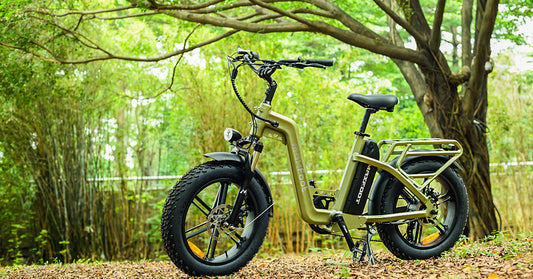The summertime is the best time to ride your electric bike outside and take in the sights and sounds of nature. On the other hand, the performance of your battery could be affected by the warmer temperature. This post offers advice on how to keep your Maxfoot E-bike's battery in working order throughout the warmer months of the year.
Shield Your Battery from Direct Sunlight
Even while you may like lazing about in the summer heat, your electric bike's battery may not feel the same way.
Avoid Prolonged Sun Exposure
The amount of time that your battery spends in direct sunlight should not exceed one hour. Extreme temperatures may cause the components that are used to create power for your Maxfoot ebike to deteriorate, which can lead to an early loss of capacity.
Indoor Storage
It is usually preferable to keep your bike indoors, but if this is not possible, you should simply remove the battery and put it in a spot that is cool and dry, away from direct sunshine, filth, debris, high temperatures, and corrosive household objects. Keeping your bike inside is always the best option for storing it.
Charging Conditions
When it is time to charge your battery, you should always make sure to keep it out of the direct sunlight and away from extreme temperatures. Find a place indoors that is cool (between 50- and 77-degrees Fahrenheit) and shady (at least some of the time).
Avoid Riding in Extreme Heat
Avoid riding your Maxfoot bike when the temperature is over 44 degrees Celsius (113 degrees Fahrenheit) to protect the life of the battery and the distance it can go on a single charge.
Overheating Prevention
Your battery, like the batteries in most other types of electrical devices, including the batteries in most mobile phones, will automatically turn off in order to save itself from overheating if it gets too hot. This is a standard function of its protective controls, and it kicks in if the temperature within the device becomes higher than 140 degrees.
Cool-Down Period
Don't freak out if the overheating of your battery causes it to shut down. It will need to return to the average temperature before we can use it normally again. Bring your battery inside for approximately an hour, preferably in a setting with temperatures ranging from 50 to 77 degrees Fahrenheit.
Stay Away from Salt and Saltwater
The summer season often brings vacations to the beach; however, keep in mind that saltwater is not your battery's buddy.
Risks of Salt Exposure
The corrosive nature of salt is matched by its outstanding electrical conductivity. It is best to steer clear of riding your Maxfoot electric bike in environments where it is possible that you may come into contact with salt or seawater, such as straight on the beach.
Cleaning After Salt Exposure
However, there are precautions you may take in the event that you come into contact with salt or seawater, which will lessen the likelihood that your bicycle or its battery will be harmed. Remove your battery, wipe off the battery casing as well as the battery tray with a dry towel, and check to see that the connections are dry and spotless.
Regular Inspection and Maintenance
Your battery's health may be maintained with the aid of regular inspections.
Checking for Corrosion
Keep an eye out for any symptoms of corrosion on the battery terminals, which could seem like a speck of green dust or a film. During the charging process, check to see that the battery does not get too hot to the touch but instead remains simply warm.
Secure Attachment
Make it a habit to check that the battery is firmly attached to the frame before each trip.
Choosing the Right Replacement
In the event that your battery has to be changed, you should make sure to get the appropriate replacement battery for your model directly from Maxfoot. These batteries are created with an emphasis on enhanced durability and are intended to function in conjunction with the Maxfoot charger in a smooth manner.
Smart Traveling with Maxfoot Ebikes
Are you contemplating using your Maxfoot e-bike on a long journey? The subsections of guidance that follow are important to bear in mind.
Battery Terminal Cover
During extended rides, a Battery Terminal Cover helps keep your bike's connections safe from damage.
Removing the Battery
As an additional measure of protection from the weather, you should take the battery out of your bicycle before securing it to a rack or placing it in the back of a truck bed. This results in an approximate 7-pound weight reduction for the bike once it has been modified.
Battery Travel Case
You may avoid having to worry about your battery if you store it in a Battery Travel Case beforehand. It has room for the battery, the charger, and an extra set of keys.
Final Thoughts
Your Maxfoot e-bike battery has the potential to provide dependable power for years to come if it is utilized in the manner recommended. Keep in mind that whenever it is feasible, you should try to stay away from harsh weather, direct sunshine, and salt or seawater. Always remember to take the battery off of your bike before taking it outside, and keep a close eye out for any indications of damage as you go.




